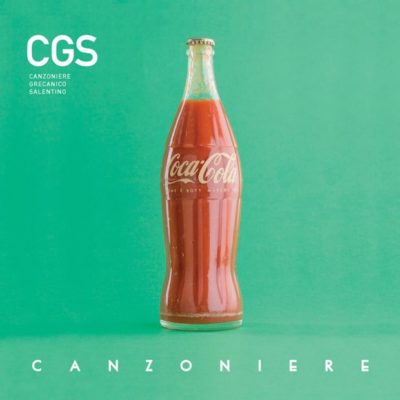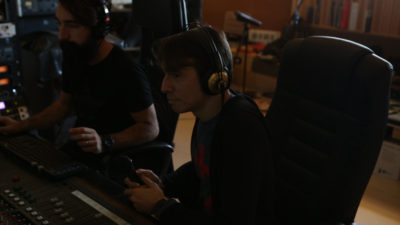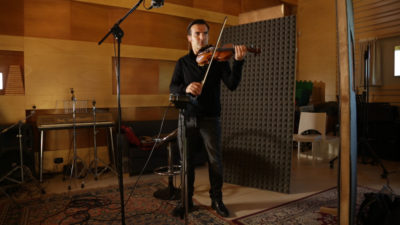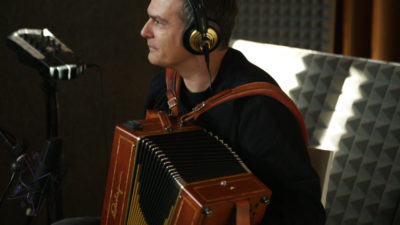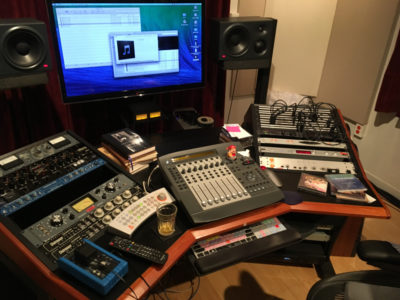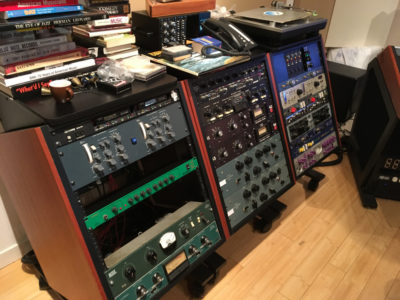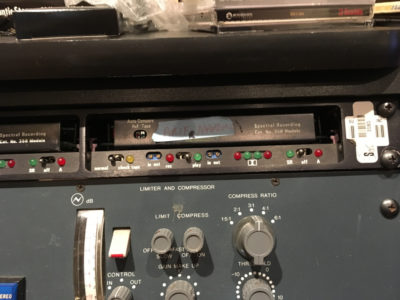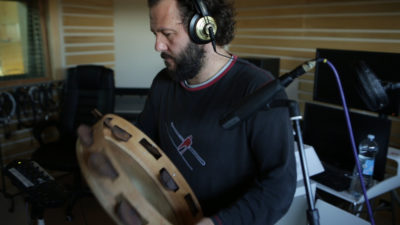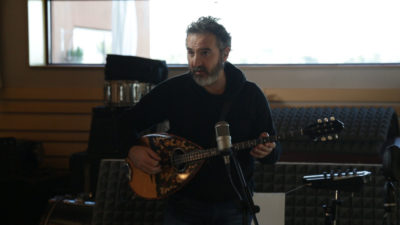Category: Canzoniere
CANZONIERE | Teatro koreja, 16 nov 2017
great photo reportage from our magic Vincenzo de Pinto
Canzoniere Grecanico Salentino: Drums like Drum Machine
No Interview – Canzoniere Grecanico Salentino: Tamburi come Drum Machine
“Canzoniere” è il nuovo album del Canzoniere Grecanico Salentino, album raffinato e moderno, in cui i tipici tamburi vengono suonati come delle drum machine e gli strumenti tradizionali si affiancano a chitarre elettriche e bassi synth. C’è il Salento e l’America, tradizione e innovazione.
Abbiamo scambiato quattro chiacchiere con Mauro Durante per conoscere meglio questo “raccolto” di canzoni.
In che senso Lecce incontra New York in questo nuovo album?
Abbiamo avuto la fortuna di avere un produttore newyorchese, Joe Mardin, che è anche coautore di 3 brani. Inoltre, altri brani sono nati dalla collaborazione con grandi musicisti newyorchesi come Scott Jacoby, Steve Skinner, Rasmus Bille Bähncke, Michael Leonhart.
Bellissima la copertina che avete scelto. Come vi è venuta in mente l’idea di rappresentare la vostra musica con due prodotti simbolo di mondi apparentemente così diversi?
Proprio come i nostri nonni usavano la bottiglia di coca-cola come contenitore della loro salsa di pomodoro fatta in casa, noi usiamo il contenitore “canzone” per la nostra salsa fatta in casa: la nostra musica, le nostre parole, il nostro vissuto e quello che noi siamo. La salsa di pomodoro conserva la sua straordinaria forza identitaria anche dentro quella bottiglia, quello che vogliamo faccia la nostra musica quando si apre al mondo.
Perché lo definite un “raccolto” di canzoni?
Perché ci piace pensare che lo abbiamo composto “raccogliendo” canzoni.Ognuna di quelle canzoni è stata seminata dopo aver preparato con cura il terreno, poi curata per farla crescere bene, e l’abbiamo raccolta solo quando era matura.
Che messaggio volete lanciare con questo album?
Un messaggio di contatto, apertura e fiducia verso il mondo. Riscoprire l’uso delle mani come mezzo per toccarsi, proteggere e resistere.
In che modo gli strumenti della vostra tradizione posso fondersi con quelli elettronici?
In realtà in questo album di elettronico c’è solo la registrazione etnografica messa in loop all’inizio de Lu Giustacofane, e l’uso di strumenti analogici elettronici come il basso moog, che però era già presente nel nostro album precedente. Le percussioni possono dare l’impressione di essere elettroniche, ma in realtà sono i nostri tamburi a cornice suonati con le nostre mani.
Si può essere moderni senza perdere la propria memoria storica?
Non si può essere moderni senza memoria storica, mancherebbe il punto di riferimento.
Ci parlate delle varie personalità che si sono avvicinate a voi in questo album e di come sono nate queste bellissime collaborazioni?
Le collaborazioni secondo noi non devono mai essere fini a se stesse, o fatte solo per inseguire il “nome” dell’ospite di prestigio. In “Canzoniere” ogni cosa è al servizio della canzone, questa è la base comune della scelta di Marco, Justin e Piers: erano semplicemente perfetti per quelle canzoni. Sono tutti nostri amici e grandissimi musicisti, che abbiamo incontrato nelle nostre tante avventure musicali.
Domanda Nonsense: Qual è il luogo segreto della vostra terra che si deve visitare almeno una volta nella vita?
La nostra terra è così bella che risulta difficile indicare un luogo in particolare. Il nostro consiglio é di “perdersi” nel Salento, lasciarsi guidare dagli istinti e scoprire da soli i luoghi più incantati.
Intervista a cura di Egle Taccia
The New Canzoniere Grecanico Salentino
Una bottiglia di Coca-cola con dentro della passata di pomodoro – la copertina di questo Canzoniere, il nuovo album del Canzoniere Grecanico Salentino – è una metafora di molte cose. Volendo, della stessa world music: polpa “di tradizione” in una nuova confezione accattivante per il mercato di massa.
Eppure, dal momento che il Canzoniere Grecanico Salentino è oggi, molto probabilmente, il gruppo italiano più visibile sul mercato delle musiche del mondo, forte di apparizioni sui maggiori palchi americani ed europei e ampiamente recensito dai media, la copertina di Canzoniere potrebbe anche essere letta come il simbolo di un rilancio del gruppo con un’immagine meno oleografica, meno gonnelloni svolazzanti e piedi scalzi, menotaranta power e più “di sostanza”, più “pop” (in senso positivo) e meno “world (in senso negativo).
Sono interpretazione libere, naturalmente. Ma ascoltandoCanzoniere non si può non notare come l’asticella della musica si sia alzata, pure in gruppo che, dopo il suo rinnovamento generazionale intorno a Mauro Durante, ormai dieci anni fa (un quarto della storia del gruppo, nato quarantadue anni fa), sulla qualità di quanto suonava e degli strumentisti ha sempre puntato molto.
Canzoniere, in effetti, è un disco prodotto benissimo, nato a New York da collaborazioni con autori e produttori di peso della scena americana: il danese Rasmus Bille Bähncke (già con Sting), che mette mano alla battiatesca “Moi”, fra i momenti migliori del disco;Michael Leonhart (Bruno Mars, Lenny Kravitz) che collabora sulla melodia a presa rapida di “Ientu”; Steve Skinner (Diana Ross e Celine Dion) che mette le mani in “Con le mie mani”; Scott Jacoby (Coldplay, John Legend, Vampire Weekend) cui si deve l’ipnotica “Lu giustacofane”. Con in più, bonus, la chitarra di Justin Adams, la voce di Piers Faccini e il violoncello Marco Decimo.
Molte idee musicali, bei suoni, cori curatissimi (con le voci di Alessia Tondo, Emanuele Licci, Giancarlo Paglialunga), un uso – finalmente! – intelligente e originale dei field recordings… Un disco che è davvero un salto in avanti in termini di produzione per la scena italiana. E fa ben sperare che si possa fare in Italia della buona musica folk-world (chiamatela come volete) per un mercato “di massa” senza adagiarsi (troppo) sui soliti cliché mediterranei e globalisti. Quarantadue anni dopo, un Nuovo Canzoniere Grecanico Salentino: speriamo possa presto vantare innumerevoli tentativi di imitazione.
Il Canzoniere Grecanico Salentino sarà in tour in tutto il mondo da novembre: partenza da “casa”, a Lecce, il 16 e 17 novembre. PoiParigi (29 novembre), Berlino (30 novembre), Firenze (1 dicembre),Mestre (2 dicembre), Roma (3 dicembre), Tallin (5 dicembre), Pärnu(6), Jõhvi (7), Tartu (8), Bruxelles (9), Milano (10), Londra (15).
Canzoniere is the Pizzica that opens up to the world
No Review – “Canzoniere” del Canzoniere Grecanico Salentino è la pizzica che si apre al mondo
Il Canzoniere Grecanico Salentino, gruppo di musica popolare salentina fondato nel lontano 1975, torna con un nuovo album, pubblicato il 27 ottobre su etichetta “Ponderosa”, dal titolo rappresentativo “Canzoniere”.
L’album, che viene definito un “raccolto” di canzoni, è un viaggio intorno al mondo con sonorità che spaziano tra moderno e tradizione. Ci sono i tamburi, c’è la pizzica, la taranta, ma anche tanti strumenti elettronici, che si fondono con il sound tipico del CGS in maniera impeccabile, segno di un lavoro attento e meticoloso, mai ridondante. Non c’è niente di stucchevole, insomma. È come se Lecce incontrasse New York, ci dicono, come se ci trascinassero in uno di quei lunghi viaggi che hanno portato la formazione a divenire una delle maggiori esponenti italiane della world music.
Per meglio comprendere la portata dell’album, vi anticipo che per “Canzoniere” sono stati scomodati grandissimi nomi del panorama mondiale quali Joe Mardin, figlio del celebre Arif, produttore dell’Atlantic Records (ha lavorato con Norah Jones e Aretha Franklin, per capirci) che ha firmato la produzione del disco, e Joe LaPorta, vincitore di un Grammy per “Blackstar” di David Bowie, che è stato invece l’ingegnere del suono per il mastering. Già questi nomi, per chi ha avuto modo di vederli all’opera, sono indicativi di quanto sia ambizioso questo album, nel quale la formazione ha deciso di prendersi qualche azzardo.
“Quannu Te Visciu” apre il disco con un ritmo trascinante e un loop ossessivo; frutto di quell’incrocio tra vecchio e nuovo di cui vi parlavo, è un brano difficile da togliersi dalla testa e rappresenta la sintesi perfetta di tutto quello che possiamo trovare nell’album. Subito dopo il sound si rilassa, ci si avvicina alla natura fermandosi ad ascoltare il vento (“Ientu”). “Lu giustacofane” parla della propria terra, di tutto il male che ha subito, della voglia di proteggerla dalla mano degli speculatori e dalle aggressioni esterne. “Con le mie mani” vede le percussioni al centro della scena. Il disco poi prende fiato e si perde nella dolcezza di “Tienime”, quasi una lettera d’amore affidata al vento, uno dei pezzi più coinvolgenti del disco. Si torna alla tradizione e ci si scatena in “Pizzica de sira”, dove la band si aggrappa alle proprie radici e alle sonorità tradizionali salentine. A questo punto i toni si scuriscono e ci addentriamo nell’antico rituale greco dell’altalena con “Aiora”, pezzo in cui vi è un bel crescendo di strumenti popolari che si incrociano alla perfezione con la chitarra elettrica di Justin Adams. “Subbra Sutta”, dove risplende la voce di Piers Faccini, il cui inglese si incrocia con il salentino, è un bellissimo momento di colore che ci porta verso il finale che si fa scuro con “La ballata degli specchi”, poi dolcissimo con “Sempre cu mie”, per esplodere infine nei colori di “Intra la danza”.
“Canzoniere” è l’ennesima prova di forza del Canzoniere Grecanico Salentino, uno dei nostri vanti musicali in tutto il mondo. Un bel viaggio della musica salentina in America, che la colora di bassi e influenze black, mantenendo però salde le proprie origini popolari. E’ colore e buio, tradizione e modernità, voglia di andarsene a scoprire il mondo tenendo stretta nel cuore la nostalgia per la propria terra.
Recensione a cura di Egle Taccia
ARTRIBUNE about our collaboration with the artistic collective CASA A MARE
la nostra collaborazione con il collettivo di arte contemporanea Casa a Mare, che ha curato la copertina e i contenuti visivi del nostro nuovo album, finisce sulla prestigiosa rivista d’arte specializzata ARTRIBUNE!
qui l’articolo firmato Claudia Giraud.
CGS on Radio24 #SoundCheck
fRoots Magazine: a complete triumph
on fRoots Magazine, one of the most prestigious world music outlets worldwide, the great Chris Nickson writes these unforgettable words for an incredible review of “Canzoniere”.
“The band is sharper than ever, the arrangements all push the songs, and the production is like crystal; every element fits perfectly. It’s a grand gesture in the very best way, and a complete triumph. How could CGS top Quaranta? They’ve just done it”
David Weiss reviewed our “Canzoniere” on SonicScoop
“One need not chase those cherished moments when listening to Canzoniere. Overwhelmed comes in waves on this new 12-song set from one of world music’s most innovative artists, Canzoniere Grecanico Salentino aka CGS. What you hear is classic and futuristic, ancient and advanced, liberating and engrossing — songs you fall instantly in love with”
fantastic piece about our “Canzoniere” by David Weiss on SonicScoop. You can read here a fantastic interview to our brilliant producer Joe Mardin, highly recommended to any sound engineer or wannabe producer.
Producer/Mixer Joe Mardin Shares His Secrets for Successful Long-Distance Collaborations
Of its many beauties, one of music’s most alluring features is its ability to overwhelm our senses. Becoming fully entranced by a recording is something that happens only occasionally, but when it does—well, that’s why a lot of us are in this business.
One need not chase those cherished moments when listening to Canzoniere by the Italian group Canzoniere Grecanico Salentino, aka CGS. Overwhelm comes in waves when listening to this new 12-song set from one of world music’s most innovative artists. What you hear is classic and futuristic, ancient and advanced, liberating and engrossing—songs you can fall instantly in love with.
The group’s roots date back to1975, when it was founded by Rina and Daniele Durante, in the Italian province of Lecce. In 2007, he handed over leadership of CGS to his son, violinist, percussionist and composer, Mauro Durante.
From there, Mauro reformed CGS into a seven-piece band—with a dancer—performing a contemporary version of southern Italy’s traditional “Pizzica” style of music and dance. The group has come to be recognized as Italy’s leading and longest-standing traditional music ensemble.
NYC-based music producer/arranger/engineer Joe Mardin had the hookup on CGS through Eric Beall, an old friend who is also the band’s New York-based publisher. Beall was arranging multiple co-writing sessions for Mauro in New York in the fall of 2015. Mardin was on the short list.
His credits with a wide range of acts were one qualifier, encompassing Queen Latifah, Aretha Franklin, George Benson, Chaka Khan, Jewel, Ofra Haza, Raul Midon and more. A proficient conductor, composer, songwriter and drummer, Mardin’s global musical knowledge prepared him for the audition.
So too did his lifetime of musical learning, taking place at the side of American music master Arif Mardin, Joe’s father whose 40+ year production and arranging career at Atlantic Records remade the soudtrack of our lives. Arif produced Aretha Franklin, the Bee Gees, Hall & Oates, the Modern Jazz Quartet, Bette Midler, Chaka Khan, Laura Nyro, Phil Collins, Barbra Streisand, and Norah Jones, winning 11 GRAMMY Awards along the way.
From that first meeting, what unfolded for Mardin and CGS was an international voyage of songwriting, producing, tracking, mixing, and discovery. The result was Canzoniere, literally translated as “Songbook” and living fully up to its name, with that aforementioned way of overwhelming again and again.
Mardin told us about his approach to managing international collaborations, and revealed a few of his key studio techniques as well.
The lead single of Canzoniere is “Lu Giustacofane”, released October 27 on Ponderosa Music&Art. You can hear it below:
Long Distance Collaboration Logistics
“Eric invited me to write with Mauro, I listened to their music and loved it — Pizzica, something I wasn’t really familiar with,” Mardin says. “CGS blends traditional instruments and melodies with modern production, traversing both folk and pop songs. A great project! At this point, I was just a co-writer and potential producer of any songs we might write together.”
Once Mardin had committed to the project, there were a number of logistical challenges to be solved. A workflow had to be established that would allow the songs to be written, recorded and mixed for maximum time and cost-effectiveness, even though the action was unfolding over two continents.
While the band wrote some material in Italy, a significant percentage of it — and portions of some of the final tracks — came from the writing sessions and studios of some of Durante’s various New York songwriting collaborators.
“Mauro and I met at my studio in New York, NuNoise and first started work on a song that was in progress, Intra La Danza which I’d help finish,” explains Mardin. “We then started and ended up writing two more songs from scratch. Later I’d help him finish another incomplete song that I thought had promise which he had started writing with the artist, Piers Faccini in England. All four ended up on the album.
“Mauro would take the sessions he started here with the various co-writers and overdub the rest of the band onto the songs back home in Italy,” he continues. “He’d then send MP3’s to the respective co-writers so we could hear the progress. He’d send me the session files or bring them on his next trip, I’d usually import them into the original sessions and we’d continue.
“Somewhere in that process, which involved Mauro coming to New York three times over the span of about a year, he asked me to produce the entire album as a way to bring continuity to—not only all of these songs which employed somewhat varying production styles—but also to the traditional ones we would cut live. Consulting with Eric (Beall) and Mark Gartenberg [CGS’ US manager/publisher] as well as with the head of CGS’ label, Titti Santini at Ponderosa Music&Art, we went into the song selection process.”
Mardin and the team gathered up the session files from the other cowriters as well as the demo sessions for the songs written in Italy, typically arriving as Pro Tools sessions but also as track bounces if they were done in an alternate DAW such as Logic. From there, they determined what they could keep, what they’d need to re-record, and what needed new ideas.
Tracking in Italy
In December 2016 Mardin arrived in Italy for two weeks, with a recording road map all ready to go.
Recording was primarily carried out in Daniele Durante’s basement Pro Tools studio, while overdubs and traditional tracks were cut live at Sudest Studio in Lecce. “Sudest is a great large room which also has a large iso booth — really another room,” says Mardin. “They have an Amek console and a bunch of good mics and outboard. The band also got a last-minute offer to do a gig in Sicily during the recording which they didn’t want to refuse — so it was pretty hectic but a lot of fun and great food of course!
Joe Mardin, in foreground, produced “Canzoniere” as part of a well-coordinated global effort. Engineer Francessco Aiello is with him at the console.
“The brilliant cellist, Marco Decimo also came in from Milan to play on several tracks including on an arrangement I wrote for violin, cello and clarinet on the song, Tienime. Guitarist Justin Adams (Robert Plant, Jah Wobble’s Invaders of the Heart) also came to town to play on the song Aiora.
“In the basement studio, we had some API and Avalon pres, various mics and we rented a Distressor, an 1176 and a couple of GA ribbon mics. The engineering duties in Italy were being split between myself and CGS’ engineer, Francessco Aiello. Let me please give a shout out to the good people at Tedes in Milan and at Soyuz Microphones who kindly loaned us the excellent Soyuz SU-017. We used it on vocals, cello, violin, percussion; a very high class mic that is all over the album.”
Back at NuNoise before Christmas, Mardin went into admin mode, digging into the task of organizing and editing the sessions in preparation for mixing. He sent Mauro Durante MP3’s of his progress prior to his arrival in New York for the final mixing, a process that was ultimately finished after Durante returned to Italy (he and his wife, Silvia Perrone who is the dancer in CGS were expecting and their son, Samuele was born in June.)
“I was sending mixes to Mauro and the band and ultimately to the label for comments and approval,” Mardin notes. “It was a privilege to be charged with shepherding the tracks created by Mauro’s super talented co-writers — Scott Jacoby, Steve Skinner, Michael Leonhardt and Rasmus Bille Bahncke — all of whom are producers in their own right and some who are very good friends of mine. Toward the end, we sent everybody mixes and asked for their blessing. I hope I did their great work justice.”
Song Genesis
Emblematic of Canzoniere’s inventiveness is the lead track “Quannu Te Visciu.” Instantly captivating the listener, it’s gorgeous weave of vocals and rhythm sends a strong signal that this is a world music album with something extra.
“‘Quannu Te Visciu’ was the first song Mauro and I wrote together from scratch,” says Mardin. “I had recently heard a piece of contemporary classical music which incorporated some spoken word, coincidentally enough in Italian and I suggested that we experiment with something similar as a starting point. That ended up becoming the vocal loop on the track performed by CGS singer, Alessia Tonde which opens the album. By the way, the majority of CGS’ lyrics are not in Italian per se but in Selentino, a dialect of Sicilian.
“We started with some percussion loops Mauro had played and pre-recorded. Mauro also came up with the lyrical idea for the vocal loop which he recited as a guide. We looped that too. The rest is the blur of singing stuff, playing each other ideas on various instruments, recording stuff and shaping it into something.”
Each of Mardin and Mauro Durante’s collaborations were written with the individual members of the group in mind. “Mauro was always thinking, ‘Giancarlo (Paglialunga) could sing this part,’ ‘this would be great as a part for Giulio (Bianco) on zampogna’ [Italian bagpipes], etc…” Mardin relates of the creative process. “Learning about these new — to me — instruments and the great talents of this wonderful group of singers and multi-instrumentalists, I was trying to be mindful too.”
For “Quannu Te Visciu” Mardin loaded a standard accordion sample to play the chords they were coming up with, which were then expanded upon by Massimiliano Morabito on organetto, an Italian folk accordion. “Great fun!” enthuses Mardin. “Mauro would put down some pizzicato violin parts which functioned somewhat like a funky guitar part. I think I also put down some additional chordal ideas which Emanuele Licci (bouzouki, guitars, etc.) would later expand upon on the bouzouki.
“Mauro would be coming up with lyrical ideas and which singer’s range would best suit certain melodies. We put the song in one key but once back in Italy with the band, Mauro changed the key so as to better match the singers’ ranges to the melodies and harmonies. With Quannu as with the other songs, I know Mauro rehearsed the band on all of the parts we’d be recording when I’d come to Italy.
“We came up with some of the background vocal arrangement in New York but I have to credit Mauro and the band for coming up with some of the more, not dissonant but harmonically rich notes in the Quannu harmonies. Beautiful!”
Mixing at NuNoise in NYC
While Mardin modestly classifies his NYC facility, NuNoise, “nothing out of the ordinary,” the fact is that it’s an inspiring personal studio. Providing an ideal analog/digital hybrid, grand piano, and drums in a compact space, Mardin is well equipped to write, record, mix and explore at NuNoise.
Helmed by a Digidesign Command 8 control surface, Klein+Hummel 0300 monitors, and Bantam patchbay, Mardin has a host of tightly curated analog pieces to choose from. Goodies on hand are mic pres including API 512 C, Neve BAE 1073, Chandler TG2, Mercury M72, UA 2-610, and the Shadow Hills Mono Gama.
Outboard highlights include dual Blackface 1176 limiting amplifiers he purchased when Atlantic Studios closed, and a pair of vintage Altec compressors formerly at Greene Street Recording, the latter of which Mardin uses as OTB inserts for vocals or key elements. Mardin specified a Retro Instruments 176 Limiting Amplifier for the lead vocal on “Quannu” and several other songs. “The lead vocal switching from singer to singer on an individual song happens on several tracks on the album, and is a CGS signature,” Mardin comments.
Benchmark and Lynx converters, along with Antelope clocking round out the setup. In general, Mardin will use all of the above for tracking, then set up a few outboard items for mixing and run the mix bus into outboard stereo compression.
To mix “Quannu Te Visciu,” Mardin made the most of the tools at hand, with the approach for “Quanna” mirroring the same basic setup for each song. “Dedicated OTB inserts or sends and returns via a Lynx Aurora 16 for the two 1176s,” he says. “The 176 on Alessia’s tracks on ‘Quannu’ which includes the rap singing in the verses and the singing in the choruses, for the Altec 1612A limiting amplifier — a real favorite which you can’t use on everything but is great when it works — on the vocal loop and for my coveted Ursa Major Space Station [digital reverb] used only on the organetto on this track.
“Plug-ins on this mix are mainly from Waves and MacDSP as well as SoundToys’ DeviLoc — a personal favorite — and Little Radiator,” he continues, “Plugin Alliance’ Vertigo on sampled bass, the Sony Oxford compressor/limiter, SofTube’s Dynamite and Saturation Knob, the former on the pizzicato violin and the bouzouki. Another real favorite of mine but not on this song is the Kush UBK-1.
“The reverb for the chorus bouzouki and background vocals and on the daf was a Waves RVerb hall at 2.4 seconds with a 28 ms pre-delay. An Altiverb cathedral impulse and the Space Station were only on the organetto which also plays only in the choruses; it is a dry-verses-big-open-choruses concept.”
Joe Mardin: “These were Arif’s Dolby SR cards. Before switching to Sony 48 track digital and Pro Tools, Arif liked the sound of SR, but the cards were known to be sonically inconsistent and so he had his own set which would go from the mix room to the mastering room. I sometimes use them strictly as an effect to either get more bottom or more high end depending on if you’re decoding or encoding the signal.”
Inside Pro Tools, Mardin set up a typical four stereo sub-master (aux) configuration: Drums & Bass, Music, Vocals, and Effects routed to two outputs on the Lynx going to an Obsidian compressor and a Pendulum Audio peak limiter — all coming back to Pro Tools via the Benchmark AD.
Tune in now for some wise compression insights. “The Obsidian was adding a little color but neither box was doing much,” says Mardin. “I find taming dynamics with a few devices/plug-ins in series doing a little, to be a little more transparent than having one do a lot. I started with a similar approach on individual tracks but then would also utilize compression in and out of the box, in series and in parallel for color.
“On this project I started using the TDR Kotelnikov compressor on the submasters as well. I found it to be pretty transparent in helping to even things out. Because Mauro and I had decided we wanted to master at Sterling Sound, I had the luxury of deferring somewhat on exactly how far to push the brightness and loudness envelope.”
Outside the Norm
Despite Mardin’s expertise, tracking and mixing Songbook was not without its challenges. With its dizzying array of classic European folk instruments — most of which are virtually unheard of in today’s mainstream music sphere — Mardin had some new sounds and musical contexts to get his head around.
Giancarlo Paglialunga on tamburello in the large iso booth at Sudest
Studio. Mics were a Sennheiser MD-421, Coles 4038 and the Soyuz SU-017 (not pictured) for
the room.
“The main percussion instrument in Pizzica is the tamburello which is a frame drum of varying sizes with a tambourine bell lined frame,” he observes. Throughout Songbook,the basic grooves, functioning somewhat analogously to kick, snare and hihat parts are played on the tamburello. Of course, there are other percussion instruments on the album — the daf supplements backbeats on Quannu and on other tracks for instance — but it’s by design that there are no snare drums and just an occasional supplementary kick sample to subtly support the tamburello on certain tracks.
“The tamburello is a challenging instrument to mic if you need it to have as much bottom and impact and ultimately function analogously to a conventional bass drum in a pop-style mix. When I recorded it, I’d have a 2-3 mics to help capture the spectrum of sounds/parts being generated. Whether with multiple mics or just one, in the mix I often used multiband compression and other tricks to get the various musical and sonic elements of a tamburello performance to sit satisfyingly in the (pop) mix.
“The ‘challenge’ or dilemma, really was that the more impact I would get out of the tamburrello or the daf, the more it tended to sound like conventional kicks and snares and Mauro was rightly conscious that these instruments should not lose their character, their connection to the band’s roots. It was a fun and new challenge and I think we struck the right balance between sonic impact and traditional authenticity.”
The album called for recording many traditional Pizzica instruments. Here, Emanuele Licci on bouzouki at Sudest Studio, tracking into a
Neumann M147. There was also a direct feed.
The project received the finishing sonic touches at Sterling Sound, where Joe LaPorta mastered — a step in the chain that Mardin sees as anything but an afterthought. “Joe and I had worked together once or twice before and it all came together,” Mardin states. “At a place like Sterling, not only do I get Joe’s expertise but with the advantage of being in a more neutral and revealing listening environment, he will also have tools to add perhaps a smoother final bit of high end than I might be able to do.
“Without defaulting to a ‘fix it in the mix (mastering)’ attitude, I would observe this type of separation of process between mixing and mastering with some of the great engineers I’ve been lucky enough to work with and watch. I think of it being akin to the great cinematographers, how they might expose film and then have the lab process it specifically to achieve the desired end result — in this sense, I do miss the creative sonic options tape offers. Joe did a great job, EQing subtly and limiting only for loudness.”
Artists’ Advocates
Much like the musical DNA of Canzoniere was steeped in equal parts tradition and advanced thinking, so too is that of the album’s producer himself. Joe Mardin began observing and collaborating with one of popular music’s most influential producers ever, his father Arif Mardin, from a young age. It’s an utterly unique vantage point that informs all the art he touches.
“My father is always in the back of my mind,” states Mardin, who produced and directed the 2010 GRAMMY nominated film, The Greatest Ears in Town: The Arif Mardin Story in tribute to the GRAMMY-winning producer who passed away in 2006. “It’s not so much on a project-to-project basis, but on things he considered priorities, what he’d say about the producer’s job: ‘I work for the artist but I’m not a yes man.’ If you have a creative disagreement with the artist, you make your case, verbally and maybe musically, too, but at the end of the day it’s the artist’s record, their name and face on the cover.
“He was, as was George Martin, as is Quincy Jones, an advocate for the artist. If the vocal was getting soft in a mix he would say, the artist has to ‘own the record.’ These things always echo in my mind: ‘Whose record is this and for whom are we making it?’
“When we were working on the end of ‘Quannu,’ I came up with that sung repeat of the title, a quick whole step up excursion which returns to the original key. I think he was in my head musically when that came to me.”
For Joe Mardin, spanning space and time with CGS was worth all the miles and careful logistics – especially the effort that kept him face-to-face with international master musicians. “The essence and beauty of this album is the collaborations on different continents,” he reflects. “But I’m also old school in that I think there is still value in the level of subtlety and service that the producer being present whenever possible provides.
“Mauro originally thought I’d only be available to come to Italy for a week but we happily settled on two weeks, and that extra time together was invaluable. And good for me! I got a second week in magical Italy!”
— David Weiss
































































